Ridenour-Baker Grocery Company Building
Introduction
Text-to-speech Audio
Consisting of four blocks, constructed between 1910 and 1919, the Ridenour-Baker Grocery Company Building is a great example of West Bottoms commercial architecture after the catastrophic floods and fires of the previous decades. It was home to a flourishing grocery company throughout the 1920s. They, like other area businesses, worked with the building's advantageous location near the railroad tracks to make money shipping goods around the country. In the 1930s, the business closed in the wake of the Great Depression, and the building was leased by a series of smaller businesses who, like Ridenour-Baker, made their living transporting goods. However, after its last owner moved out in 2003, it sadly remained vacant and fell into disrepair.
Images
The front of the Ridenour-Baker Grocery Company Building.
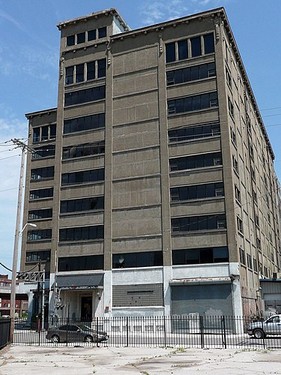
The Ridenour-Baker Grocery Company in its heyday, circa 1928. This picture has the company's letterhead and logo on the back.
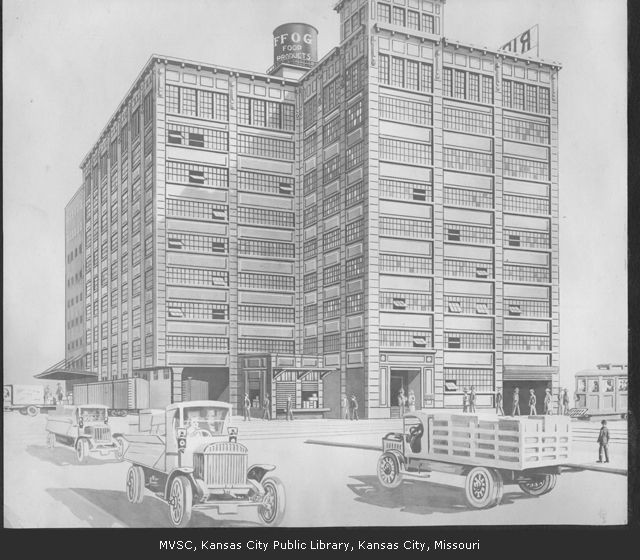
Fleet of Ridenour-Baker Grocery Company trucks parked along the side of the building, circa 1915. The building would have only been partially completed at this point.
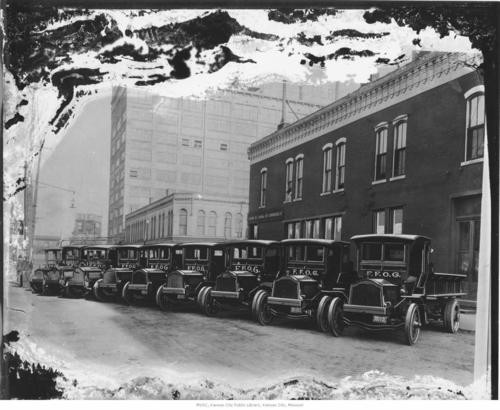
The planned layout of the new building. So far, work on demolishing the old building has not yet begun.
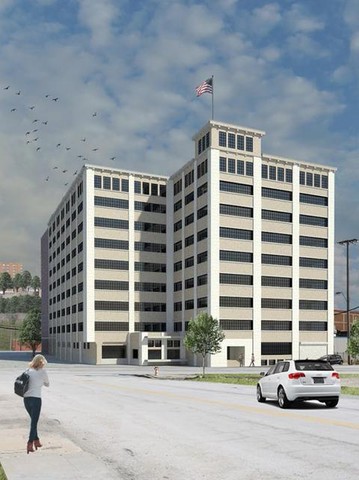
After being abandoned for nearly twenty years, the building has become "derelict," with the inside in disrepair and most of its windows broken. It will eventually be torn down.
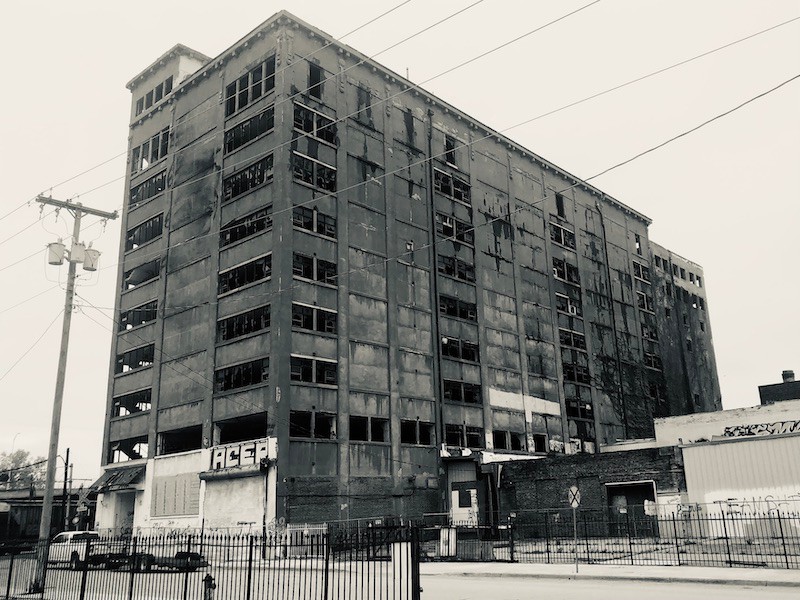
Backstory and Context
Text-to-speech Audio
The West Bottoms became a major commercial district in the last half of the nineteenth century following the construction of a railroad bridge, the first to cross the Missouri River, into the neighborhood. What followed was several decades of expansion, with numerous railroad companies expanding their lines through Kansas City and businesses putting warehouses and headquarters as close to the depot as they could get.
However, as rail traffic increased, the neighborhood became crowded, with less room for businesses to operate. In 1903 and 1908, floods devastated the area, destroying many of its buildings. Finally, in 1914, the construction of Union Station as a new passenger station took pressure off the West Bottoms. While some businesses took these events as a chance to leave the neighborhood, seeking opportunities in other parts of the city, many chose to stay, taking advantage of whatever awaited them.
One such business was the Ridenour-Baker Grocery Company. Operating in the area since 1878, this company lost its original building to the 1903 flood. Additionally, midway through the construction of their new building, a fire damaged the complex, one of several to impact West Bottoms businesses during the 1910s. As a result, much of the unfinished building needed to be rebuilt. When finishing their work, the builders kept the possibility of floods and fires in mind. Like other newer buildings in the area, the Ridenour-Baker Building was built with no basements, a new measure to prevent flood damage. It was made of reinforced concrete, a then state-of-the-art fireproofing measure. Its flat roof and simple, minimally decorated exterior were encouraged by city officials for some time after the floods.
It is clear from looking at the Ridenour-Baker Building that it was built with its company's needs in mind. Despite the movement of some businesses to Union Station, there was still significant railroad traffic through the area from the 1910s onward, so much of this company's business would have had to do with shipping goods. The building's large size, proximity to the street and railroad tracks, and ample loading dock allowed for this. These features enabled the company to store what they needed before quickly and efficiently loading it onto train cars to be sent elsewhere in the country.
Ridenour-Baker flourished for some time during and after its construction. Despite losing seventy-one of its 350 employees when they enlisted in the military during World War I, the company became a prominent local supporter of the war effort, successfully fundraising over $300,000 for the Red Cross and United War Work. They were significant contributors to the grocery industry during the 1920s. However, the company began to struggle during the early Great Depression thanks to the declining economy and competition in other midwestern cities such as Omaha. Finally, Ridenour-Baker dissolved in 1936 after the retirement of co-founder Edward Ridenour.
After this, the building leased its space to several smaller businesses. Most of these companies, like Ridenour-Baker, made their homes in West Bottoms to take advantage of the neighborhood's opportunities. Most of the early renters were transportation companies. Later, companies used the building's capabilities as a warehouse, using it as storage space while preparing to send their goods away on trains, just as Ridenour-Baker had done. The most recent company to work out of the building was Weld Wheel Industries, Inc., from 1978 to 2003. Since then, the building has been vacant. Developer William Reeder announced plans in 2015 to convert the building into apartments. However, as of 2022, plans have changed to demolishing the building completely, as it has become "too deteriorated to be adapted," and just making a new building. As of October 2022, demolition efforts have not yet begun.
Cite This Entry
Rieber, Ellie. "Ridenour-Baker Grocery Company Building." Clio: Your Guide to History. October 21, 2022. Accessed March 18, 2025. https://theclio.com/entry/157949
Sources
Rosin, Elizabeth. Ridenour-Baker Grocery Company Building - National Register of Historic Places Registration Form, Missouri State Parks. October 1st, 2013. Accessed October 15th, 2022. https://mostateparks.com/sites/mostateparks/files/Ridenour-Baker%20Grocery%20Co.%20Bldg.pdf.
Roberts, Rob. West Bottoms grocery site plants seeds for historic credits, Kansas City Business Journal. November 20th, 2013. Accessed October 21st, 2022. https://www.bizjournals.com/kansascity/news/2013/11/20/west-bottoms-grocery-site-plants-seeds.html.
Stafford, Diane. 'Artist funky' lofts will rise in the West Bottoms, Kansas City Star. March 19th, 2015. Accessed October 21st, 2022. https://en.wikipedia.org/wiki/Ridenour-Baker_Grocery_Company_Building#cite_note-:1-7.
Collison, Kevin. Developers’ plan for massive West Bottoms investment stirs fear in some neighbors, Starland News. July 9th, 2022. Accessed October 21st, 2022. https://www.startlandnews.com/2022/07/someraroad-west-bottoms/.
Wikimedia
Missouri Valley Special Collections
KC History - The Kansas City Public Library
Kansas City Business Journal
Starland News

